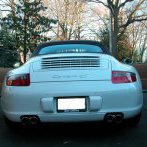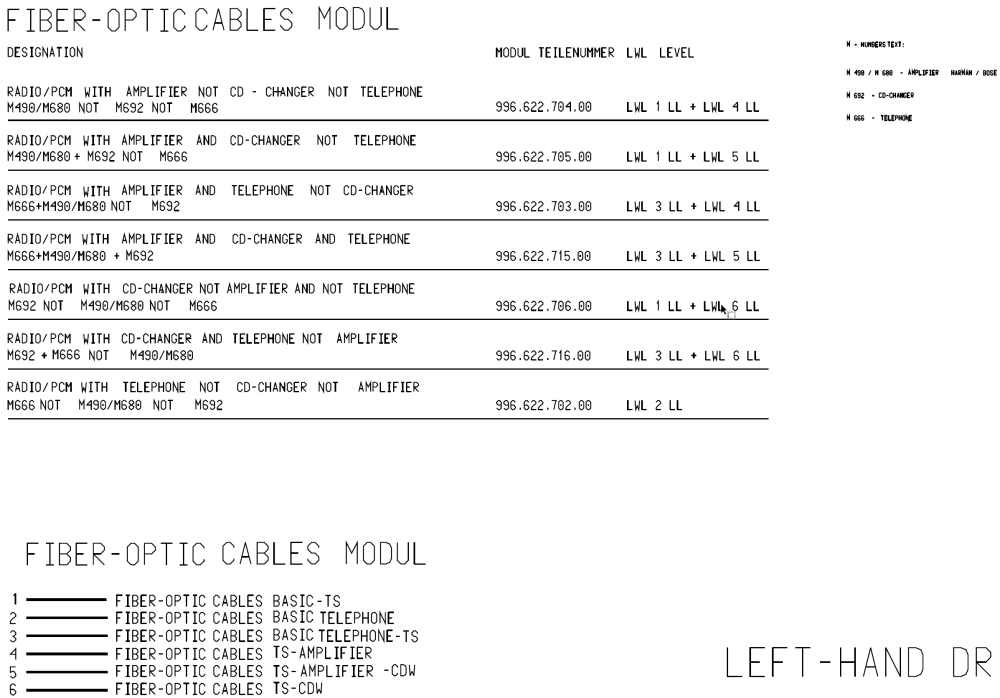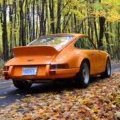Intake air side, air routing
General information
The air cleaners and the intake systems of the 3.6- and 3.8-liter engines have been
redesigned for direct fuel injection (DFI) in order to achieve an ideal torque curve.
The modified the air box and the air cleaner upper section bearing the new plaque
with the "PORSCHE DIRECT FUEL INJECTIION" logo and the suffix "3.6" or "3.8" are
the key elements that enhance the engine compartment design. Re-routing of the
hoses and lines also contributes to an attractive appearance of the engine compartment.
Air cleaners
The air cleaners for the new 911 models have been completely revised. Compared
to the single-branch air-cleaner system with integral intake snorkel in the predecessor
models, the new engines feature a two-branch air-cleaner system with two intake
locations and separate intake snorkels located in the rear lid. The air-cleaner system
was converted from a plate filter to two round filters.
These measures offer the following advantages:
Lower inflow resistance values
Longer maintenance intervals for the air-cleaner elements
The new 2-branch air intake system reduces inflow losses and therefore the engine
intake resistance. In turn, this helps to increase the engine power. The 2-branch
intake system permitted wider use of the entire filter surface. More uniform soiling
of the filter surface means longer maintenance intervals for the filter elements. The
picture shows the lower section of air cleaner with the two air filters (L) and the
sound openings (S).
Sound openings in the lower section of the air cleaner
In order to ensure the typical Porsche intake sound in the interior, the new air-cleaner
housings also feature sound openings (S) in the lower section of the air cleaner. As
in the predecessor models, they consist of large openings with inserted, nearly airtight
polyamide material to avoid the intake of warm air from the engine compartment.
3.8 liters of resonance volume in the air cleaner housing
Besides the additional designation "3.8", the air cleaner housing of the Carrera S
models with 3.8-liter engine is, as with the 3.6-liter model, distinguished from the
predecessor models by the actively activatable resonance volume (RV) in the air
cleaner housing of the 3.6 l model. Activation takes place under map control and
with temperature compensation via a vacuum-controlled flap (UK), which is activated
by the electro-pneumatic switching valve on the right side of the air cleaner housing.
Activating and/or deactivating the resonance volume improves the intake sound of
the 3.8-liter engine, especially in connection with its specific intake system.
Intake system
As in the predecessor models, the newly developed intake systems of the 3.6- and
3.8-liter engines with resonance distributor and additional sound chambers consist
of plastic.
Compared to the predecessor models, the following areas of the intake systems
have been modified:
New design
New production method
Distributor tube with integral resonance tube
Intake distributor with resonance chamber
Adapted intake-pipe lengths and diameters
The illustrations show the intake system of the 3.6-liter engine and the resonance
tube (without tuning flap). The transverse resonance tube, which was a separate
component next to the distribution tube in the predecessor models, has been integrated
into the distribution tube. This permits a compact, weight-saving assembly.
Tuning flap in the 3.8-liter engine
The resonance intake system of the 3.8-liter engine is distinguished from the intake
system of the 3.6-liter engine by virtue of an additional, actively activatable tuning
flap in the resonance distributor between the intake manifolds. This resonance
intake system, which can be activated in two stages, influences and makes use of
air oscillations in the intake system at different engine speeds, thereby producing
high torque values at low engine speeds, a uniform torque curve in the mid rpm
range and high maximum power at high speeds by way of the better engine charging
values generated in this manner.
The tuning flap is actuated by a vacuum-controlled diaphragm cell (MD). It is activated
as controlled by the map by an electro-pneumatic switching valve installed on the
resonance tube. Under load, the tuning flap is closed between approx. 3,000 and
5,500 rpm and opened at lower and higher engine speeds.
Tuning flaps in the intake distributors
The intake systems of both engine versions are enhanced by sound volumes in the
intake distributors. They attenuate disturbing resonance sounds in the upper rpm
range (5,000 – 6,000 rpm) and make an important contribution to the harmonic,
powerful sound profile at full throttle. The design principle for the resonance chambers
was adopted from the 3.8-liter engine of the predecessor models. The additional
chambers are integrated into the lateral intake distributors and are connected to
them via a perforated partition with numerous small openings.












-0001-0001.thumb.png.17f5bb25bf8ec261a17c21e6321c8492.png)









